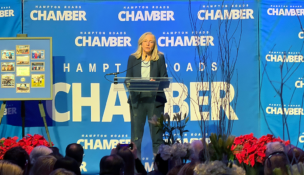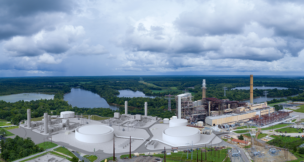US government halts nearly complete offshore wind farm. Is Virginia’s next?
Dominion Energy's $10.9 billion offshore wind farm is 60% complete

Dominion Energy’s Coastal Virginia Offshore Wind (CVOW) project. Courtesy Dominion Energy.

Dominion Energy’s Coastal Virginia Offshore Wind (CVOW) project. Courtesy Dominion Energy.
US government halts nearly complete offshore wind farm. Is Virginia’s next?
Dominion Energy's $10.9 billion offshore wind farm is 60% complete
SUMMARY:
- The Trump administration halted the nearly complete Revolution Wind project off the coast of Rhode Island and Connecticut
- Pause raises questions about whether Dominion Energy’s $10.9 billion Coastal Virginia Offshore Wind project in Virginia Beach will share the same fate
- Dominion says CVOW is critical for Virginia’s economy, jobs and energy goals
After the Trump administration has ordered a halt to construction of a nearly complete $4 billion offshore wind farm off the coast of Rhode Island and Connecticut, it’s reasonable to wonder whether Dominion Energy‘s $10.9 billion Coastal Virginia Offshore Wind project off the coast of Virginia Beach could be in similar peril.
On Aug. 22, the federal Bureau of Ocean Energy Management stopped Orsted’s Revolution Wind project, which already has 45 of 65 turbines installed, along with all underwater foundations. Citing a January memorandum by President Donald Trump, BOEM told Orsted North America to “halt all ongoing activities related to the Revolution Wind Project” while the federal government reviews potential national security concerns.
According to CNBC, the Revolution Wind project was about 80% complete when the Trump administration forced it to stop construction. Meanwhile, the Trump administration also filed court documents Aug. 22 stating it intends to revoke federal approval for US Wind’s planned Maryland Offshore Wind Project, which has not begun construction.
Large, ocean-based wind farms are part of utilities’ plans to shift to renewable energy, particularly in populous East Coast states with limited land for onshore wind turbines or solar arrays. But President Donald Trump has made sweeping strides to prioritize fossil fuels and hinder renewable energy projects. Those include reviewing wind and solar energy permits, canceling plans to use large areas of federal waters for new offshore wind development and stopping work on another offshore wind project under construction for New York. However, construction was later allowed to resume.
“Americans deserve energy that is affordable, reliable, and built to last — not experimental and expensive wind projects that are proven failures,” Interior Department Deputy Press Secretary Aubrie Spady said in a statement distributed to media.
In Virginia, construction on Richmond-based Fortune 500 utility Dominion Energy’s CVOW wind farm 27 miles off the Virginia Beach coast is about 60% complete. As of Monday, the CVOW project remained on schedule for full completion in late 2026, according to Dominion spokesperson Jeremy L. Slayton. Once operational, CVOW will consist of 176 wind turbines generating up to 9.5 million megawatt-hours per year of energy, or enough to power up to 660,000 homes.
Dominion would not directly address whether it thought the Virginia offshore wind project is at risk of a similar stop-work order from BOEM. However, Slayton provided the following statement: “Coastal Virginia Offshore Wind is a customer-driven project only months away from delivering its first power to Virginia’s economy. Virginia’s shipyards, military bases, defense manufacturers and data centers are depending on power from CVOW to fuel Virginia’s growing economy. The project is supporting thousands of jobs and billions of dollars of investment in Hampton Roads. It has broad, bipartisan support and is a critical part of Virginia’s all of the above energy strategy.”
Brett Massimino, chair of the department of supply chain management and analytics at Virginia Commonwealth University, said he’s not optimistic about the project being completed as originally planned.
About six months ago, Massimino spoke with Dominion officials who indicated that the project “wasn’t going as planned” and expressed concerns about its cost.
Since that time, Massimino said, those concerns have become amplified by events such as Trump’s “crackdown” on alternative energy sources and Dominion stating that Trump’s trade war would likely increase CVOW’s cost by $500 million.
Now, Massimino thinks the project “could be either paused or killed.”
In his opinion, he said, “I don’t see … Dominion finishing the project out the way it was originally planned to be. Whether that is just stopping at this point, wherever they are in construction, and running with what they have, or if it involves terminating the project entirely and shutting it down, I don’t know.”
Gov. Glenn Youngkin’s office did not immediately respond to requests for comment. Youngkin has previously expressed support for offshore wind in Virginia. However, Massimino said he believes the governor will be “limited” in preventing the federal government from halting CVOW if the Trump administration chooses to intervene.
“I think the federal government is going to do what they want to do,” Massimino said, “and I think Youngkin’s voice is going to be kind of marginalized right now because of the end of his term coming up.”
Tariffs and Trump’s policies will continue to impact offshore wind projects nationwide, he added: “I think by holding these projects, I think the progress, or the hope of establishing any significant offshore wind program nationally, all those hopes are kind of getting dashed at this point.”
Dominion incurred $73 million in tariffs through the end of the second quarter of this year. If the current tariff policy continues through the end of the third quarter, tariff costs would increase to $193 million and if policy continues through the end of 2026, total tariff costs would be $506 million, Slayton said in an email.
Accounting for tariff costs through the end of this year’s third quarter, Dominion increased the total project cost estimate from $10.8 billion to $10.9 billion. Slayton said that will add an average of 3 cents to residential customers’ monthly bills over the life of the project.
Revolution Wind pause
Meanwhile, Democratic governors, members of congress and union workers have called for the Trump administration to let construction resume on the Revolution Wind project. Rhode Island Gov. Dan McKee says Revolution Wind is critical to the region’s economy and energy future.
Revolution Wind is expected to be Rhode Island and Connecticut’s first large offshore wind farm, capable of powering more than 350,000 homes. Power would be provided at a rate of 9.8 cents per kilowatt hour, locked in for 20 years. That is cheaper than the average cost of electricity in New England.
The developer, Danish energy company Orsted, is evaluating the financial impact of stopping construction and considering legal proceedings.
The project site is more than 15 miles (24 kilometers) south of the Rhode Island coast, 32 miles (51 kilometers) southeast of the Connecticut coast and 12 miles (19 kilometers) southwest of Martha’s Vineyard. Rhode Island is already home to one offshore wind farm in state waters, the five-turbine Block Island Wind Farm.
The Trump administration previously stopped work on Empire Wind, the New York offshore wind project. Interior Secretary Doug Burgum said it appeared former President Joe Biden’s administration had “rushed through” the approvals, although the developer Equinor spent seven years obtaining permits. Construction was allowed to resume in May after two of the state’s Democratic leaders, U.S. Sen. Chuck Schumer and Gov. Kathy Hochul, intervened.
i
















